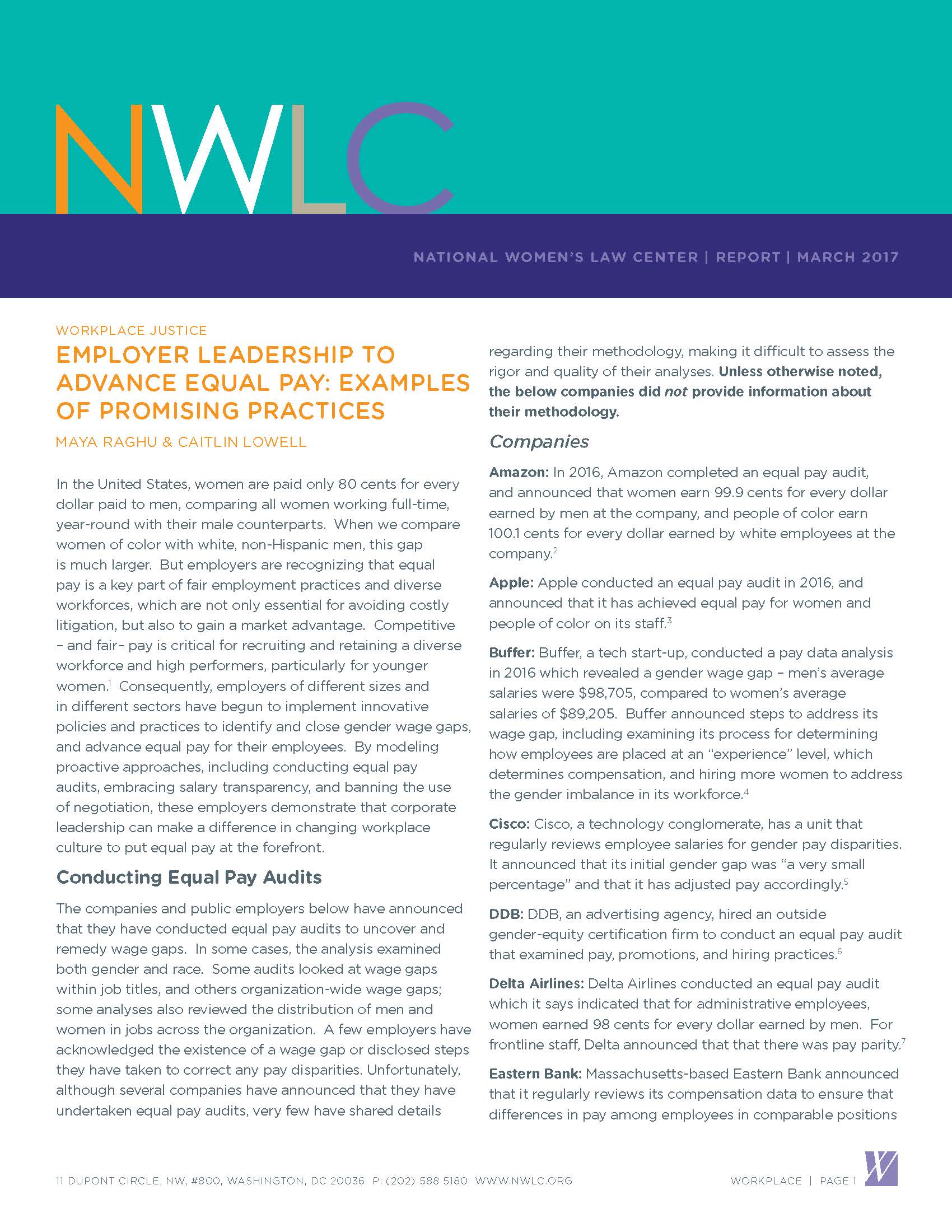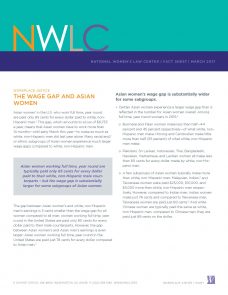Abortion rights, women of color, and LGBTQI+ people are under attack. Pledge to join us in fighting for gender justice.

 Asian women in the U.S. who work full time, year round are paid only 85 cents for every dollar paid to white, non-Hispanic men. This gap, which amounts to a loss of $8,733 a year, means that Asian women have to work more than 14 months—until early March this year—to make as much as white, non-Hispanic men did last year alone. Many racial and/or ethnic subgroups of Asian women experience much larger wage gaps compared to white, non-Hispanic men.
Asian women in the U.S. who work full time, year round are paid only 85 cents for every dollar paid to white, non-Hispanic men. This gap, which amounts to a loss of $8,733 a year, means that Asian women have to work more than 14 months—until early March this year—to make as much as white, non-Hispanic men did last year alone. Many racial and/or ethnic subgroups of Asian women experience much larger wage gaps compared to white, non-Hispanic men.
Asian women working full time, year round are typically paid only 85 cents for every dollar paid to their white, non-Hispanic male counterparts – but the wage gap is substantially larger for some subgroups of Asian women.
The gap between Asian women’s and white, non-Hispanic men’s earnings is 5 cents smaller than the wage gap for all women compared to all men: women working full time, year round in the United States are paid only 80 cents for every dollar paid to their male counterparts. However, the gap between Asian women’s and Asian men’s earnings is even larger: Asian women working full time, year round in the United States are paid just 78 cents for every dollar compared to Asian men.
Some subgroups of Asian women experience substantially wider wage gaps.
- Certain Asian women experience a larger wage gap than is reflected in the number for Asian women overall. Among full time, year round workers in 2015:
- Burmese and Fijian women make less than half—44 percent and 45 percent respectively—of what white, non-Hispanic men make. Hmong and Cambodian make little more than half (55 percent) of what white, non-Hispanic men make.
- Pakistani, Sri Lankan, Indonesian, Thai, Bangladeshi, Hawaiian, Vietnamese, and Laotian women all make less than 80 cents for every dollar made by white, non-Hispanic men.
- A few subgroups of Asian women typically make more than white, non-Hispanic men: Malaysian, Indian, and Taiwanese women were paid $25,000, $10,000, and $5,000 more than white, non-Hispanic men respectively. However, compared to Indian men, Indian women make just 76 cents and compared to Taiwanese men, Taiwanese women are paid just 80 cents. And while Chinese women are typically paid the same as white, non-Hispanic men, compared to Chinese men, they are paid just 89 cents on the dollar.
Over her career, an Asian woman typically loses at least $349,000 to the wage gap; in some states, the situation is much worse.
- In 1988, the earliest year for which data are available, an Asian woman working full time, year round typically made only 69 cents for every dollar paid to her white, non-Hispanic male counterpart. By 2015, this figure stood at 85 cents—16 cents less than it was a quarter of a century ago.
- While the wage gap has narrowed somewhat over the last few decades, Asian women still typically lose $349,320 to the wage gap over a 40-year career. This means Asian women have to work more than 47 years to make what white, non-Hispanic men were paid in just 40 years.
- In many states, Asian women stand to lose more than half a million dollars over a 40-year career as compared to white, non-Hispanic men.
- In Alaska, the state with the largest lifetime losses for Asian women due to the wage gap, Asian women stand to lose more than $1 million over a 40-year career. The typical Asian woman living in Alaska would have to work for more than 77 years to make what white, non-Hispanic men made in just 40 years.
Asian women experience a wage gap at every education level, and it is widest among those with the least education.
- Among full time, year round workers, Asian women without a high school degree typically make only 64 cents for every dollar white, non-Hispanic men without a high school degree make. Asian women with an associate’s degree typically make less—by about $8,076 each year—than white, non-Hispanic men with only a high school degree (about 83 cents for every dollar).
- While the wage gap for Asian women declines as they obtain more education, Asian women must obtain a bachelor’s degree or more before their typical wages exceed those of white, non-Hispanic men without a bachelor’s degree. Asian women with a bachelor’s degree are paid $60,660—only about 18 cents more ($1.18) for every dollar paid to white, non-Hispanic men with some college but no degree.
Asian women’s wage gap is widest among older women.
- Among full time, year round workers ages 25–44, Asian women typically make 97 cents for every dollar white, non-Hispanic men make—but older Asian women experience far larger wage gaps. Asian women ages 45–64 make 69 cents for every dollar made by their white, non-Hispanic male counterparts, and Asian women 65 and older make only 58 cents for every dollar made by white, non-Hispanic men. These larger gaps mean that Asian women are falling behind at the very time they need additional resources to invest in their families and save for retirement.
Asian women experience a wage gap across occupations.
- In a wide variety of occupations—those that are well-paid and poorly paid, those that are female-dominated and those that are non-traditional for women—Asian women working full time, year round make less than white, non-Hispanic men.
- Asian women working as physicians and surgeons—a male-dominated, high-wage occupation—make 57 cents for every dollar paid to their white, non-Hispanic male counterparts.
- Asian women working as customer service representatives—a mid-wage, female-dominated occupation—make 80 cents for every dollar paid to their white, non-Hispanic male counterparts.
- Asian women working as hand laborers and freight, stock, and material movers—a male-dominated, low-wage occupation—make 76 cents for every dollar paid to their white, non-Hispanic male counterparts.
- Asian women working as child care workers—a female-dominated, low-wage occupation—make 82 cents for every dollar paid to their white, non-Hispanic male counterparts.
- In addition to wage gaps within occupations, Asian women are overrepresented in the most poorly paid jobs in the nation. Asian women’s share of the low-wage workforce (3.9 percent) is nearly 1.4 times larger than their share of the overall workforce (2.8 percent). Even in low-wage occupations, Asian women working full time, year round experience a wage gap, making only 81 cents for every dollar white, non-Hispanic men make.

